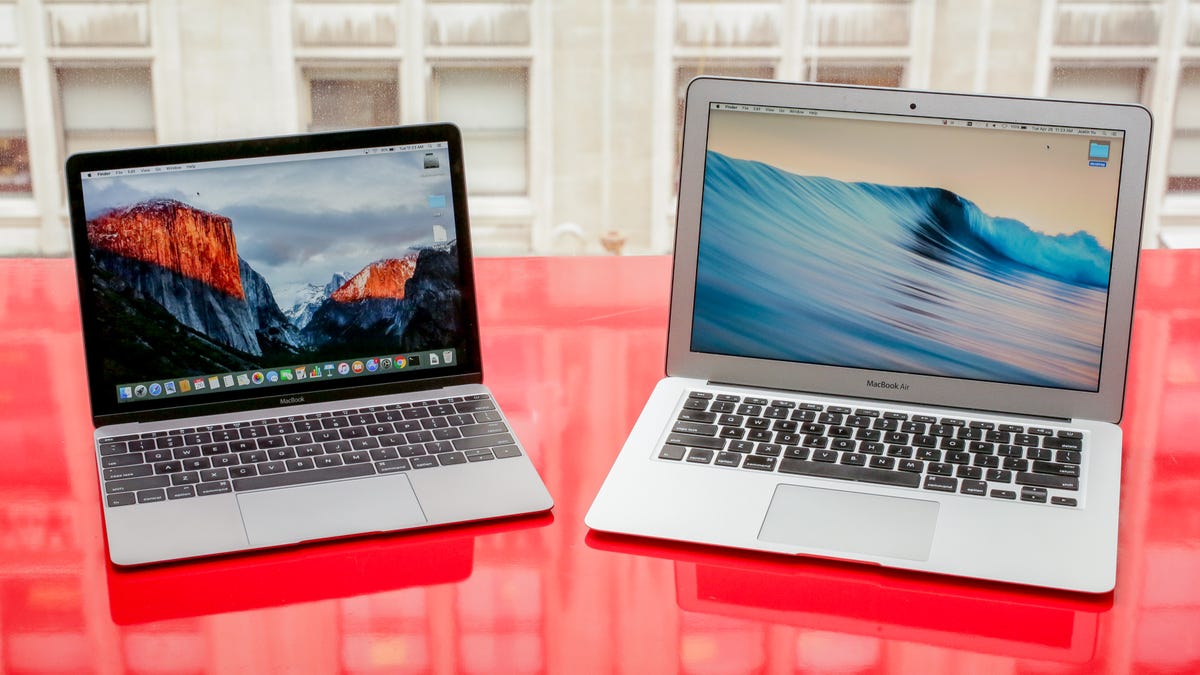 Why You Can Trust CNET
Why You Can Trust CNET MacBook vs. MacBook Air: What's the difference?
Apple's shiny MacBook is appealing, and oh so different than the MacBook Air. Just how different? Let's take a look.

The new Macbook isn't just a prettier, updated version of the MacBook Air. Some features and specs got massive updates, while other features (like ports, for one), were sacrificed in the making.
If you're considering a new Macbook and finding yourself comparing the two options, look out for these major differences.
Where are the ports?
Outside of the 3.5mm headphone jack, the USB Type-C port is the only port you'll find on the MacBook. Through this single interface you charge, sync and connect accessories to the MacBook.
Meaning, if you want to connect the MacBook to an external monitor and an iPhone at the same time, for example, you'll need a $79 adapter from Apple. (There are some third-party USB Type-C adapters for the MacBook that are cheaper, but reviews are mixed so proceed with caution should you decide to go that route.)
The MacBook Air is much more generous. It's equipped with two USB ports, a Thunderbolt port and a MagSafe 2 port for charging. With all those options, you can sync a camera, charge your iPhone, and use an external monitor -- with ports to spare.
That screen, though
Apple continues to add its Retina display to more of its products, but the MacBook Air has been left behind. Both the 11-inch and 13-inch Macbook Air models are outfitted with lower-resolution screens, with the 13-inch model offering a resolution of 1440-by-900.
The MacBook's is a lot sharper. Its 12-inch display is a Retina screen with a resolution of 2304-by-1440.
And in case you're wondering: yes, you'll see the difference. With all those extra pixels, text appears sharper (and easier on the eyes), images show more detail and colors are more vibrant. More simply put, everything just looks better on a Retina display.
Speed
One of the tradeoffs you'll have to make when going with the MacBook is overall processing power.
Inside the MacBook is Intel's Core M processor, which is designed to be as energy-efficient as possible and doesn't need fans to keep it cool. A side effect of that efficiency, though, is the Core M line isn't nearly as powerful as the Intel Core i5/i7 processors currently available in the MacBook Air.
For the average person, the speed difference may be noticeable but won't hamper your productivity. But if you're someone who wants to multitask with apps like Photoshop or iMovie, the sluggishness will be more apparent.
Color coordinate all the things
Unlike the standard silver color scheme of the MacBook Air, the new MacBook comes in the same colors as the iPhone, iPad, and Apple Watch. If you're so inclined, you can coordinate your gold, rose gold, space grey, or silver MacBook to match your phone, tablet and watch.
The color of your computer isn't going to have any impact on its overall performance, but if having a laptop that reflects your affinity for a certain color appeals to you, the MacBook is calling your name.
Battery
Apple is proud of the fact the MacBook is crammed full batteries stacked atop one another, filling every possible millimeter of its housing. Thanks to this design, the MacBook's battery should net you roughly 10 hours of web browsing.
Due to its bigger footprint, the 13-inch MacBook Air has a big enough battery to best the MacBook's battery performance by two hours, with 12 total hours of web browsing. Either device should offer enough juice to get through a long study session or a typical workday on the go. Then again, those two extra hours could really make a difference for someone who is constantly traveling.
Storage and memory
With a recent product refresh, the 13-inch MacBook Air now ships with 8 GB of memory and 128 GB of storage for $999. The base model MacBook also includes eight gigabytes of memory, but the storage amount is doubled to 256 GB for $1,299.
Force Touch
The MacBook's trackpad is equipped with Force Touch, a feature that's also found on the Apple Watch and iPhone 6S (albeit under a different name, 3D Touch).
By applying varying degrees of pressure on the trackpad of the MacBook, OS X will display extra menus and actions depending on what app you're in. For example, force clicking on a link in the Mail app will open a preview window of the webpage the link will take you to. Apple has yet to add this feature to the MacBook Air line.

